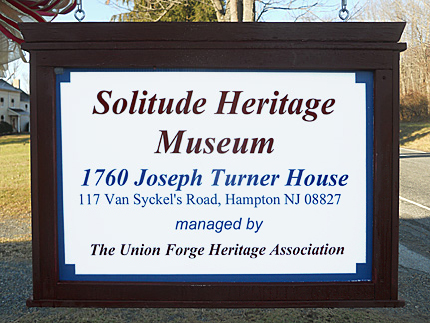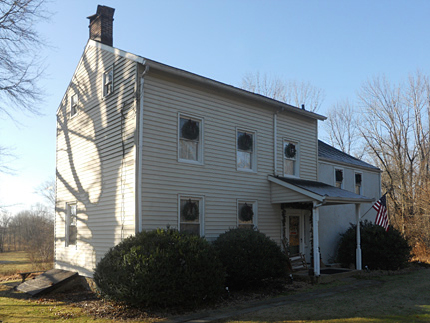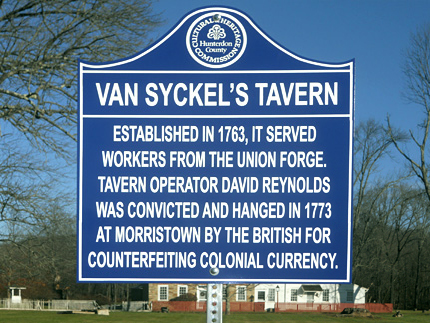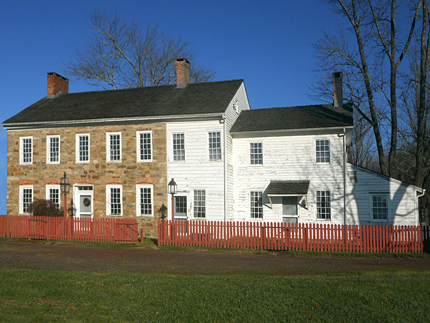



Solitude Heritage Museum / 1760 Joseph Turner House
117 Van Syckel's Rd.
Map / Directions to Solitude Heritage Museum
For information about visiting the Solitude Heritage Museum,
see the Union Forge Heritage Association website
Joseph Turner House and the Union Iron Works [1]
The Union Iron Works began operation in 1742. Its property extended over a seventeen-square-mile area in Hunterdon County, which included iron mines and the buildings and equipment needed to produce iron goods. The Union Iron Works operated two iron furnaces in what are now Clinton and High Bridge.
The owners of Union Iron Works were William Allen and Joseph Turner. This house was owned by Joseph Turner.
When the Revolutionary War began, Turner and Allen had to flee their property because they were Loyalists. (Loyalists were Americans who remained loyal to the British in the Revolutionary War.) Robert Taylor, who had been their bookkeeper, then became the superintendent of Union Iron Works.
In the decades before the war, Union Iron Works had produced such items as horseshoes, farm tools, and fireplace backs. With the coming of the war, the iron works became important to the military effort because of the production of such items as cannon balls and rifle barrels.
It required an enormous amount of heat energy to run the furnace to work with iron. Melting iron to a workable state requires maintaining temperatures over 2000 degrees. To keep the furnaces burning here, an acre of trees was cut down every day to be burned. By 1781, the trees in the forest surrounding the Clinton furnace had been used up and that furnace ceased production. Union Iron Works then focused its work on the furnace in High Bridge.
The house is now a museum run by the Union Forge Heritage Association. It contains numerous items related to the iron works and the Revolutionary War era, including cannonballs, iron ingots and molds, tools and financial documents.
Workers at the Union forge were served by the nearby Reynolds Tavern, which is described in the entry below, and has an interesting Revolutionary War era history of its own.



Van Syckel's Tavern
Van Syckel's Rd. and Rt. 635
Map / Directions to Van Syckel's Tavern
This house is a private residence.
Please respect the privacy and property of the owners.
David Reynolds and Reynolds Tavern
This house was used as a tavern in the 1700's into the 1800's. Today it is usually referred to as Van Syckel's tavern, but it was not called that until over a decade after the Revolutionary War ended. It was first known as Reynolds Tavern, after its original owner, David Reynolds, who built the building in 1763. [2]
Although Reynolds would not live to see the Revolutionary War, he and his tavern were connected with interesting incidents in the decade before the war began.
The Stamp Act and the Sons of Liberty
In 1765, ten years before the beginning of the Revolutionary War, the British Parliament passed the Stamp Act, which imposed a tax on a wide range of paper items in the thirteen British colonies in America. The Stamp Act was unpopular throughout the colonies. Groups calling themselves the Sons of Liberty formed to protest the Stamp Act and to defend the rights of the colonists.
A Sons of Liberty group was formed in lower Hunterdon County. Residents of the township of Bethlehem met at Reynolds Tavern on March 11, 1766, to choose three delegates to represent them at an upcoming meeting of the Sons of Liberty group in Ringoes. (What is now Hampton Borough was then part of Bethlehem Township.) Reynolds was chosen as one of the three men to represent Bethlehem at the meeting at Ringoes. [3]
The Stamp Act was soon repealed by the British Parliament, but the tensions which it had caused would continue to grow and would eventually lead to the beginning of the Revolutionary War in 1775.
David Reynolds and the Counterfeiting Ring [4]
Before thirteen colonies in America declared their Independence from Britain during the Revolutionary War, each of the individual colonies printed its own currency.
A man named Samuel Ford began counterfeiting currency for the colonies of New Jersey, Pennsylvania, and New York in the 1760's. He was apparently very successful in his counterfeiting and produced fake bills which fooled most people. He operated his counterfeiting press in great secrecy.
Sometime before 1773, David Reynolds was brought into Ford's counterfeiting ring. In addition to helping with the distribution of the counterfeit bills, Reynolds also helped Ford procure type for his printing press.
In the summer of 1773, Ford and one of his accomplices were captured and held prisoner at the jail on the Morristown Green. They managed to escape. Four other men, including David Reynolds, were then arrested for having taken part in the counterfeiting ring and were also held at the jail in Morristown.
The four prisoners were scheduled to be executed on September 17. The other three men ended up having a delay put on their execution and were later pardoned, but Reynolds was hanged that day before a large crowd at the jail on the Morristown Green.

1. ^ Information for this entry was drawn from:
WiIIiam E. Honachefsky, "Three Hundred Years of Solitude," 2016, Skylands Visitor website
National Register of Historic Places / Inventory - Nomination Form for the Chew / Turner / Carhart Farm
Available as a PDF on the National Park Service website hereHistorical plagues at the Solitude House in High Bridge
2. ^ National Register of Historic Places / Inventory - Nomination Form for the Van Syckel Corner District
Available as a PDF on the National Park Service website here3. ^ Minutes of a Bethlehem Town Meeting on March 11, 1766, recorded by Bethlehem Township Clerk Francis McShane, as reprinted in:
James P. Snell, History of Hunterdon and Somerset Counties, New Jersey (Philadelphia: Everts & Peck, 1881) Page 459
Available to be read at the Internet Archive here
▸ Note that one of the other two men chosen at this meeting was Abraham Bonnell, whose own tavern still stands in Clinton.4. ^ Information for this section about the counterfeiting was drawn from six newspaper articles from 1773 and 1774, which were reprinted in:
William Nelson, A. Van Doren Honeyman, Editors, Documents Relating to the Colonial History of the State of New Jersey, First Series, Volume 29 (Paterson: Call Printing and Publishing Co., 1917) Pages 15-19, 28-29, 32-35, 119-122, and 141.
▸ The specific articles are listed below with links to the appropriate pages of the book at the Internet Archive.
• "As the public are interested, so they must be anxious to know the result...," The Pennsylvania Gazette, No. 2334, September 15, 1773
Reprinted on pages 15-19 of Documents Relating to...• "We hear from Morris-Town, New-Jersey, that on Friday last was executed...," The Pennsylvania Journal; and The Weekly Advertiser, No. 1607, September 22, 1776
Reprinted on page 28 of Documents Relating to...• "Last Friday between ten and twelve o'clock...," Rivington's New-York Gazeteer: or the Connecticut, New Jersey, Hudson-River and Quebec Weekly, No. 23, September 23, 1773
Reprinted on pages 28-29 of Documents Relating to...• "On Friday the 17th Instant at Morris Town in East New Jersey, was executed, David Reynolds...," The New-York Gazette: and The Weekly Mercury, No. 1144, September 27, 1773
Reprinted on pages 32-35 of Documents Relating to...• "Speech of his Excellency William Franklin, Esq," The New-York Gazette; and The Weekly Mercury, No. 1153, November 29, 1773
Reprinted on pages 119-122 of Documents Relating to...• "His Excellency Governor Franklin, of New-Jersey, has been pleased with the Advice...," The New-York Gazette; and The Weekly Mercury, No. 1155, December 13, 1773
Reprinted on page 141 of Documents Relating to...• "Lately observing two publications in your paper...," The New York Journal; or, The General Advertiser, No. 1626, March 3, 1774
Reprinted on pages 276-282 of Documents Relating to...